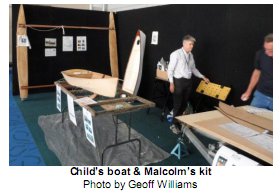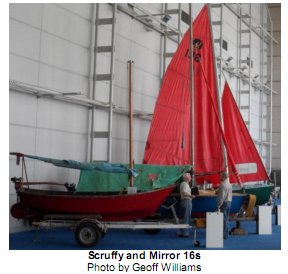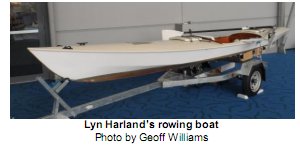Once again we had a good selection of boats on display and for the show this year. We had two themes: (1) to encourage new builders with our stitch and glue practical demonstration which drew plenty of attention and Malcolm Hodgen plans showing CNC ply kit panels; and (2) Our display of very used and loved older boats with Chris Treloar’s Scruffie 14 complete with SEAGULL, Geoff Williams’ Mirror 16, and also Larry Loveday’s Mirror 16 rigged with overnight camping mattress and tent cover together with a SEAGULL on the stern.
 So many visitors said “My dad used to have a boat with one of those motors”.
So many visitors said “My dad used to have a boat with one of those motors”.
We also had immaculate boats from John Morrison’s Mirror 10 and Wee Rob canoes, Tony Harland’s row boat built for his wife Lyn’s use, Dan Robinson’s Clinker, Ian Oughtred 10-2 Puffin and David Micklethwaite’s restored Welsford Navigator and last but not least the immaculate Murray Iles Splinter built by Rob Rasmussen.
 Our thanks to all Members who came in to man the stands and help with the stitch and glue demonstrations. I am sure once again we will get more new members and encourage others to build a boat that they have always wanted to do.
Our thanks to all Members who came in to man the stands and help with the stitch and glue demonstrations. I am sure once again we will get more new members and encourage others to build a boat that they have always wanted to do.
Ed’s additional notes:
At the risk of being excommunicated from the WBAQ, I thought the display opposite ours in the foyer of the Convention Centre was very interesting. It was a small light-weight boat for roof-topping. The 3m version weighted in at 40kg. It was constructed of resin impregnated foam between layers of fibreglass, using a vacuum to expel the air from the construction and also facilitate the resin infusion – a very brief and possibly not totally accurate description of the construction process. The result was a hull (of simple form) with 13mm thick sides and 15mm thick bottom, all constructed of a buoyant material requiring no additional built in buoyancy, allowing the Australian Builders Plate to state “Level flotation”. But the construction process is not important to us, although the result is. The idea of foam (or similar) core construction is not new, but I haven’t seen it applied to such a small simple boat before. It would be interesting to consider a “wooden boat” equivalent – thin ply external and internal skins with suitable buoyancy between. It would probably need fibreglass covering externally for puncture resistance. I wonder how the weight would compare.




